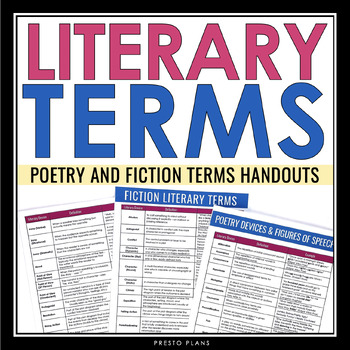Literary Devices for Poetry & Fiction List - Figurative Language Literary Terms
- Zip
What educators are saying
Also included in
- This poetry unit resource bundle is a collection of my most popular and best-selling poetry analysis and writing resources! Make poetry fun for your students with this huge bundle that contains over 470 slides and pages of creative and engaging poetry resources that will save you hours and hours ofPrice $49.99Original Price $85.83Save $35.84
Description
This literary devices for poetry and fiction list is a must-have for all high school English language arts teachers. Included is a complete list of 38 literary devices, figurative language, and literary terms that you will use in your classroom during your poetry, short story, or novel unit.
This is included in the following discounted bundles:
>>> Figurative Language Resource Bundle
How to use this literary devices for poetry and fiction list:
This is a very useful reference for students to have on hand in your classroom. I recommend printing these reference pages during back to school or at the beginning of a new course. Have students keep them in their binders or notebook to reference while they complete their work.
When students aren't sure of the meaning of a literary device you are using, have them go back to find the answer themselves on their handouts. This will help them better recall the information in the future.
What's included in this resource:
These three pages include definitions and examples for 38 different literary terms. The literary devices are organized by genre (poetry or fiction) and alphabetically, so students can easily locate the term they are looking for.
The examples of literary devices come from a variety of sources like movies, children's stories, famous poems, or pieces of literature.
What terms are included on the literary devices for poetry and fiction list:
Poetry: Alliteration, Assonance, Consonance, Hyperbole, Metaphor, Onomatopoeia, Oxymoron, Personification, Pun, Simile, Imagery, Symbolism, and Synecdoche
Fiction: Allusion, Antagonist, Conflict, Character (Dynamic, Flat, Round, Static), Climax, Exposition, Falling Action, Foreshadowing, Flashback, Irony (Verbal, Situational, Dramatic), Mood, Point of View (First Person, Third Person, Omniscient), Protagonist, Resolution, Rising Action, Setting, Satire, and Theme
What teachers are saying about the literary devices for poetry and fiction list:
⭐️⭐️⭐️⭐️⭐️ This was a well-organized, concise way to provide all my students with the terms they really need to know. We use it at least a couple of times a week as a reference. I will end up using this over and over again.
⭐️⭐️⭐️⭐️⭐️ This is a comprehensive list and should be perfect for student binders. Thank you!
⭐️⭐️⭐️⭐️⭐️ Great resource for my 8th-grade students. They used this as a go-to reference throughout our poetry unit.
Pair this with our best-selling literary term of the week resource:
© Presto Plans
➡️ Want 10 free ELA resources sent to your inbox? Click here!
⭐️ Follow Presto Plans on TpT to see what's new and on sale.






